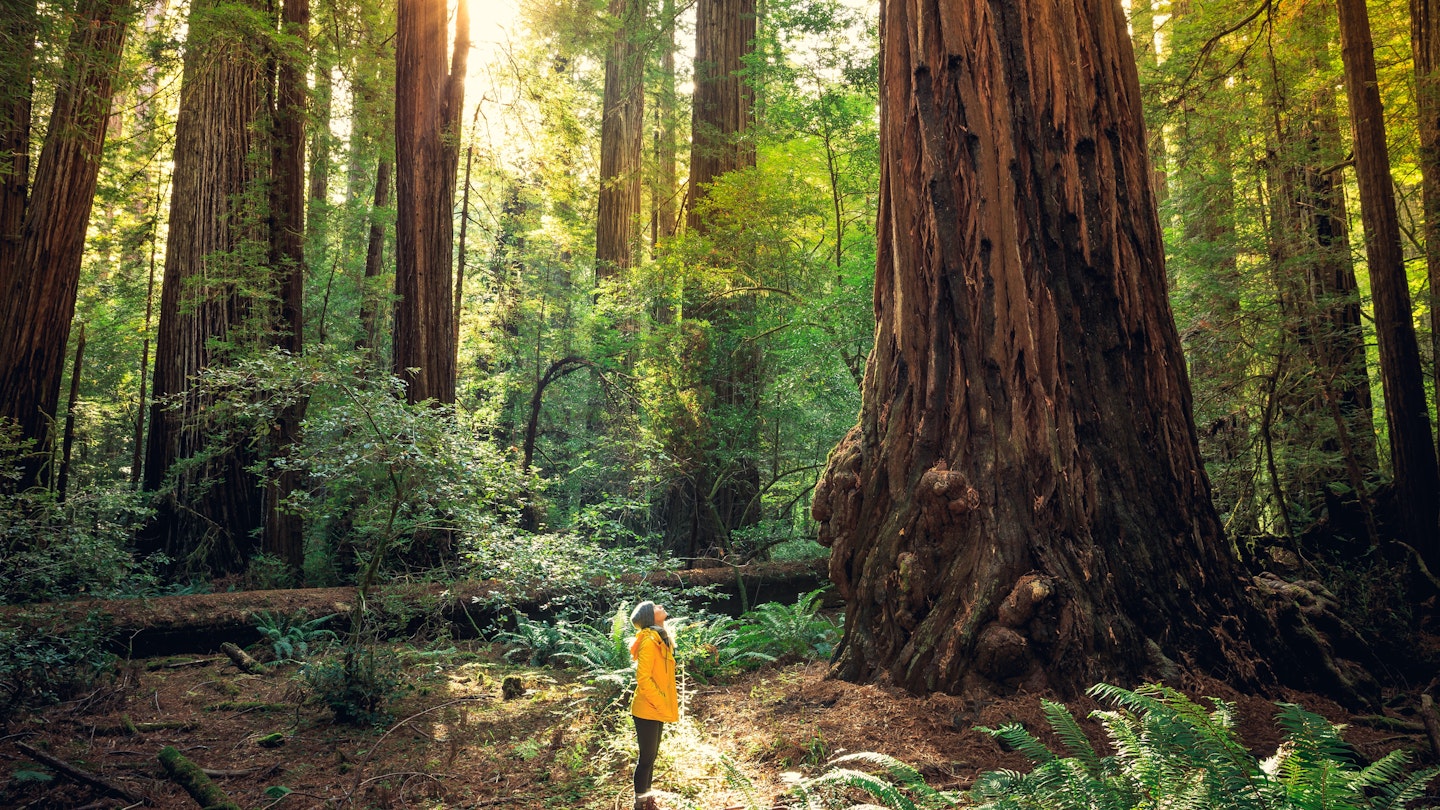The USA packs spectacular biodiversity within its borders, boasting some of the most beautiful places in America. Within the 50 states, you’ll encounter incredible natural landmarks, including hot desert playas, towering mountain ranges topped by glaciers, rolling grasslands, tropical rainforests, active volcanic zones, and polar tundra.
Many of the USA’s most magnificent natural wonders are protected today by the National Park Service (NPS). These specially protected places also provide a safe haven for an astonishing array of wildlife, ranging from tiny eyeless fish living in the dark haunts of Mammoth Cave to the giant grizzly bears of wild Denali National Park. Scattered from coast to coast, here’s our pick of the most breathtaking natural landmarks in the USA.
1. Redwood National and State Parks, California
The world’s tallest trees grow on the fog-kissed Northern California coast. Redwoods can reach a height of 379ft, taller than the Statue of Liberty in NYC, and live for up to two millennia. Almost half of the remaining old-growth redwood trees that have never been logged are protected by the chain of Redwood National and State Parks.
Planning tip: To hike the 4.5-mile Tall Trees Trail, you will need to apply for a reservation in advance.
2. Grand Canyon National Park, Arizona
Measuring a mile deep, up to 18 miles wide, and more than 275 miles long, no other sight in the USA beats this giant hole in the ground for instilling awe. Peering over the edge of the Grand Canyon offers a thrilling experience, but to truly appreciate the canyon’s grandeur, hike down to the rushing Colorado River.
Planning tip: To escape the crowds, visit the canyon’s North Rim, which gets significantly fewer visitors than the South Rim. However, beware that services are limited during the winter months.

3. Yosemite National Park, California
Famous conservationist John Muir called Yosemite nature’s temple. Gazing up at towering granite monoliths such as El Capitan and at Yosemite Falls, North America’s highest waterfall, you’ll understand his sentiment. Declared a UNESCO World Heritage Site, Yosemite sustains a variety of rare wildlife inhabiting California’s Sierra Nevada mountain range.
Planning tip: Yosemite Valley’s waterfalls peak in late spring, a quieter time to visit the park compared to summer.
4. Niagara Falls, New York
Niagara Falls consists of three powerful waterfalls that gush along the US-Canada boundary: Horseshoe Falls, American Falls, and Bridal Veil Falls. While they might not be the tallest, these waterfalls boast a greater water flow than any others on the planet. Experience it up close with a Maid of the Mist boat tour for a unique view.
Planning tip: The Canadian side of the falls offers more natural beauty, so consider crossing the border.

5. Yellowstone National Park, Wyoming
Yellowstone, the USA’s oldest national park, is a wonderland of unique geology and wildlife. At this UNESCO World Heritage Site, you’ll be amazed by the world’s largest collection of geysers, including hot springs and steaming fumaroles. Keep an eye out for herds of bison roaming freely.
Planning tip: Visiting during early fall can help you avoid the largest crowds, but be ready for cold temperatures.
6. Kilauea Volcano, Hawaii
On Hawaiʻi, the Big Island, Kilauea Volcano has been erupting since 1983, making it one of the world’s longest continuous eruptions. Experience geological forces birthing new land at Hawaiʻi Volcanoes National Park, a UNESCO World Heritage site. According to Hawaiian tradition, the fiery lava lake in Halemaʻumaʻu Crater is the home of Pele, the goddess of fire and volcanoes.
Planning tip: Check official park resources for eruption updates and current viewing conditions of active lava.

7. Denali National Park, Alaska
In the indigenous Koyukon language, Denali means “the high one,” which is fitting since it stands as North America’s highest peak at 20,310ft. It’s even taller than Everest when measured from its base. First summited in 1913, Denali sees thousands of climbers attempt to reach its south summit every year.
Planning tip: Flightseeing tours are available from nearby towns, providing incredible aerial views of this majestic landscape.
8. Mammoth Cave, Kentucky
In America’s heartland, Mammoth Cave is the world’s longest cave system. It features nearly 400 miles of underground passageways sculpted by subterranean rivers. Visitors can see uniquely shaped stalactites, stalagmites, and an array of captivating cave formations during guided tours.
Planning tip: Be prepared for cooler temperatures inside the cave; a sweater or jacket is advisable.

9. Monument Valley, Arizona
Chances are that those epic landscapes you’ve seen in classic Hollywood Westerns were filmed in Monument Valley, where stunning sandstone buttes rise up to 1000ft above the desert floor. Now a Navajo tribal park, it offers breathtaking views and guided horseback tours for a unique perspective.
Planning tip: The Navajo Nation observes Mountain Standard Time and follows Daylight Saving Time, different from neighboring Arizona.
10. Acadia National Park, Maine
On the picturesque Atlantic coast, Acadia is a maritime treasure. Don’t miss the chance to hike Cadillac Mountain, the tallest peak on the Atlantic seaboard. Climb to the summit for a breathtaking sunrise experience, and consider visiting during autumn for stunning foliage views.
Planning tip: Renting bicycles in Bar Harbor allows for car-free exploration of the park.





